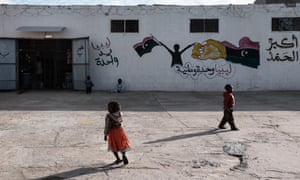Militia-run detention centres in Libya are ‘no more than forced labour camps and makeshift prisons’, Unicef says

Children outside a government-run detention centre in Libya. Photograph: Romenzi/Unicef
Women and children making the dangerous journey to Europe to flee poverty and conflicts in Africa are being beaten, raped and starved in “living hellholes” in Libya, the United Nations children’s agency, Unicef, has said.
Children are being sexually abused, coerced into prostitution and work, and held to ransom for months in squalid, overcrowded detention centres, as they flee war and poverty in Africa to undertake one of the most dangerous journeys in the world to Europe, the agency warned in a new report.
Last year, more than 181,000 refugees and migrants, including more than 25,800 unaccompanied children, arrived in Italy via the central Mediterranean smuggling route, through Libya. Thousands of people died on the way.
Unofficial detention centres controlled by militia serve as lucrative businesses that profit from trafficking, and are “no more than forced labour camps … and makeshift prisons”, Unicef said. “For the thousands of migrant women and children incarcerated, [the centres] were living hellholes where people were held for months.”
Three-quarters of migrant children interviewed in Libya by the International Organisation for Cooperation and Emergency Aid, (IOCEA) a Unicef partner, reported experiencing violence, harassment or aggression at the hands of adults during their journey to Italy. The “snapshot” survey of 122 women and child migrants also found a growing number of teenage girls forced by smugglers to have Depo-Provera contraceptive jabs, so they could be raped without becoming pregnant.
Sexual violence and abuse was widespread and systematic at crossings and checkpoints. A third of the women and children interviewed said their assailants wore uniforms or appeared to be associated with the military. Nearly half of the women and children reported sexual abuse during migration, often multiple times and in multiple locations, the report found.
“The central Mediterranean from north Africa to Europe is among the world’s deadliest and most dangerous migrant routes for children and women,” said Afshan Khan, Unicef regional director and special coordinator for the refugee and response crises in Europe. “The route is mostly controlled by smugglers, traffickers and other people seeking to prey upon desperate children and women who are simply seeking refuge or a better life. We need safe and legal pathways and safeguards to protect migrating children that keep them safe and keep predators at bay.”
The Unicef study, A Deadly Journey for Children (pdf), found most women and children had paid smugglers at the beginning of their journey, under “pay as you go” schemes, leaving many of them in debt and vulnerable to abuse, abduction and trafficking.
The study found that children whose parents have not paid enough money to smugglers were held to ransom for thousands of dollars, mostly between Sudan or Libya, or in Libya itself.
Most said they expected to spend extended periods working in Libya to pay for the next leg of the journey. One Nigerian boy, aged 15, who was held in a Libyan detention centre, told IOCEA: “Here they treat us like chickens. They beat us, they do not give us good water and good food. They harass us. So many people are dying here, dying from disease, freezing to death.”
A survey by IOM in October found that 70% of migrants travelling overland through north Africa to Europe have become victims of human trafficking and exploitation along the way, and a pattern of torture, forced labour and arbitrary detention of migrants and asylum seekers in Libya has been documented by the UN.
This year is proving the deadliest yet for the central Mediterranean migration route, a billion-dollar industry controlled by criminal networks. The International Migration Institute reported 326 people travelling from Libya to Italy died at sea, between 1 January and 22 February, a 300% increase on the same time last year when 97 died. Last year, 4,579 people died making the crossing between the Mediterranean between Libya and Italy – equivalent to one in 40 – including an estimated 700 children. The UN has said nightmarish conditions in Libya were helping drive a surge in the numbers of migrants attempting to reach Italy in the depths of winter.
Some 34 detention centres have been identified in Libya, holding between 4,000 and 7,000 detainees, of which 24 are run by the Libyan government department for combating illegal migration (DCIM). Unicef, which only has access to fewer than half of the government-run centres and none of those run by militia, reported some had 20 people crammed into cells not larger than two square metres for long periods of time, it said.
Justin Forsyth, deputy executive director of Unicef, said: “The results of this rapid assessment demand action. We can’t have a situation where children and women disappear into a hellhole. They are being sexually assaulted, abused, exploited and killed.”
The report called on Libya, the EU and the international community to establish safe and legal pathways for children fleeing war or poverty along the route.
This month the EU backed an agreement between Italy and Libya to stem the arrival of migrants to Europe, which prompted condemnation by human rights groups.
Lily Caprani, Unicef UK’s deputy executive director, urged MPs to vote to support more unaccompanied child refugees in a vote on Tuesday in parliament. She said: “Because the safe and legal routes available are so limited, traffickers and smugglers control the route, preying on vulnerable children seeking a better life in Europe and UK. Even when children reach Europe, the traffickers and smugglers continue to control and coerce these children. The stories revealed in this work are harrowing – no child should face these horrors.
“The UK government deserves credit for supporting vulnerable children in conflict affected states, but it must also protect these vulnerable children in Europe by providing safe and legal pathways to the UK for those who have a legal claim.”
Source: The Guardian


